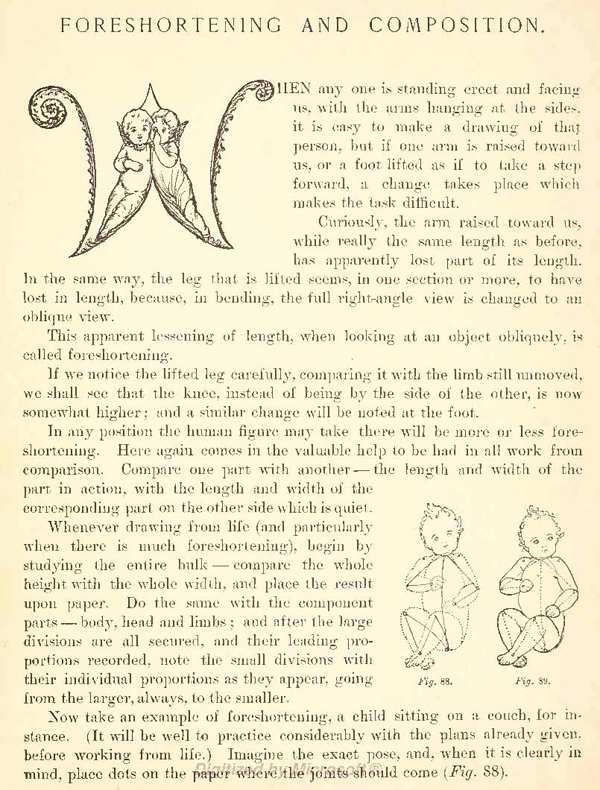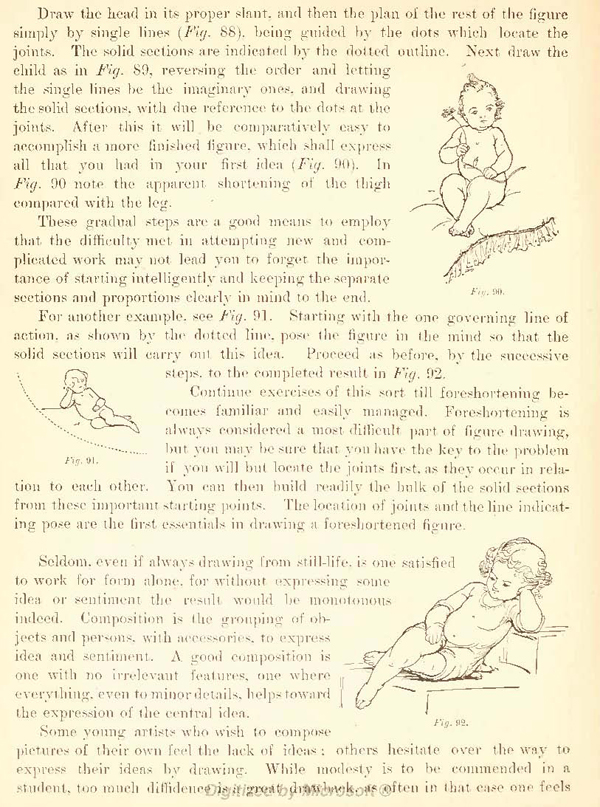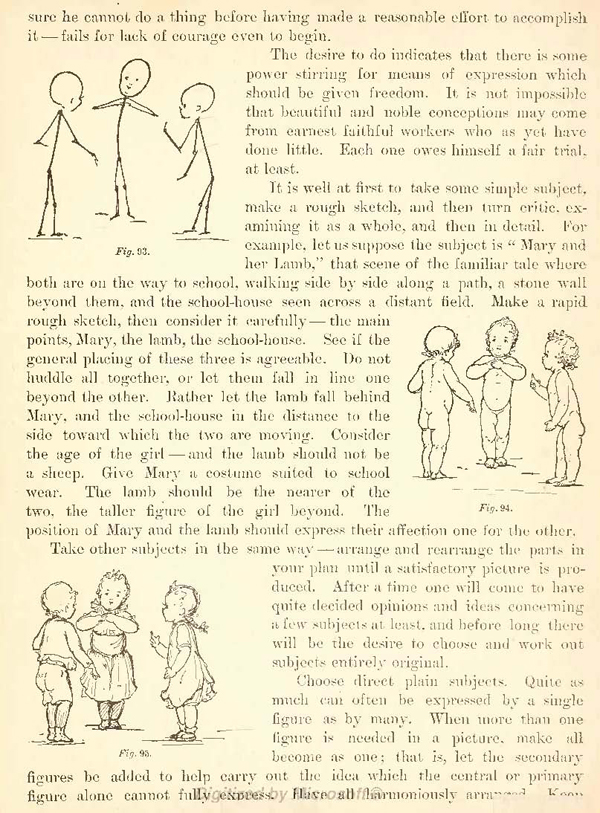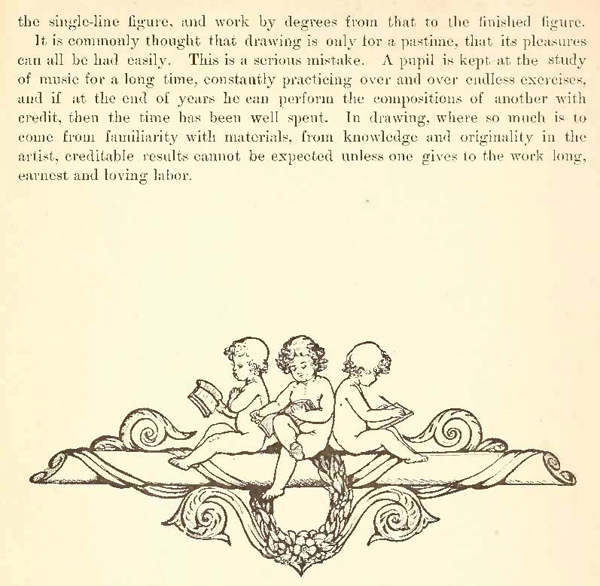Home > Drawing Lessons Directory> Perspective Drawing > Foreshortening > Drawing Children's Figures with Proper Foreshortening and Composition
Foreshortening and Composition of human figures and while drawing children / kids / babies
|
|
[The above words are pictures of text, below is the actual text if you need to copy a paragraph or two] FORESHORTENING AND COMPOSITION.When any one is standing up straightand facing us, with the arms hanging at the sides. it is easy to make a drawing of that person, but if one arm is raised toward us, or a foot lifted as if to take a step forward, a change takes place which makes the task difficult. Curiously, the arm raised toward us, while really the same length as before, has apparently lost part of its length. In the same way, the leg that is lifted seems, in one section or more, to have lost in length, because, in bending, the full right-angle view is changed to an oblique view. This apparent lessening of length, when looking at an object obliquely, is called foreshortening. If we notice the lifted leg carefully, comparing it with the limb still unmoved, we shall see that the knee, instead of being by the side of the other, is now somewhat higher ; and a similar change will be noted at the foot. In any position the human figure may take there will be more or less foreshortening. Here again comes in the valuable help to be had in all work from comparison. Compare one part with another — the length and width of the part in action, with the length and width of the corresponding part on the other side which is quiet. Whenever drawing from life (and particularly when there is much foreshortening), begin by studying the entire bulk — compare the whole height with the whole width, and place the result upon paper. Do the same with the component parts — body, head and limbs; and after the large divisions are all secured, and their leading proportions recorded, note the small divisions with their individual proportions as they appear, going from the larger, always, to the smaller. Now take an example of foreshortening, a child sitting stance. (It will be well to practice considerably with the plans before working from life.) Imagine the exact pose, and, when mind, place dots on the paper f where the joints should come on a couch, for in-already given, it is clearly in 88). Draw the head in its proper slant, and then the plan of the rest of the figure simply by single lines (Fig. SS), being guided by the clots which locate the joints. The solid sections are indicated by the clotted outline. Next draw the child as in Fig. 89, reversing the order and letting the single lines be the imaginary ones, and drawing the solid sections, with due reference to the dots at the joints. After this it will . be comparatively easy to accomplish a more finished figure, which shall express all that you had in your first idea (Fig. 90). In Fig. 90 note the apparent shortening of the thigh compared with the leg. For another example, see Fig. 91. Starting with the one governing line of action, as shown by the dotted line. pose the figure in the mind so that the solid sections will carry out this idea. Proceed as before. by the successive steps, to the completed result in Fig. 92. Continue exercises of this sort till foreshortening becomes familiar and easily managed. Foreshortening is always considered a most difficult part of figure drawing, but von may be sure that you have the key to the problem if you will but locate the joints first. as they occur in relation to each other. You can then build readily the bulk of the solid sections from these important starting points. The location of joints and the line indicating pose are the first essentials in drawing a foreshortened figure. Seldom, even if always drawing from still-life. is one satisfied to work for form alone, for without expressing some idea, or sentiment the result would be monotonous indeed. Composition is the grouping of objects and persons. with accessories, to express idea and sentiment. A good composition is one with no irrelevant features, one where everything, even to minor details, helps toward the expression of the central idea. The desire to do indicates that there is some power stirring for means of expression which should be given freedom. It, is not impossible that beautiful and noble conceptions may come from earnest faithful workers who as yet have done little. Each one owes himself a fair trial, at least. It is well at first to take some simple subject, make a rough sketch, and then turn critic. examining it as a whole, and then in detail. For example, let us suppose the subject is " Mary and her Lamb," that scene of the familiar tale where both are on the way to school, walking side by side along a path, a stone wall beyond them, and the school-house seen across a distant field. Make a rapid_ rough sketch, then consider it carefully— the main points, Mary, the lamb, the school-house. See if the general placing of these three is agreeable. Do not huddle all together, or let them fall in line one beyond the other. Rather let the lamb fall behind Mary, and the school-house in the distance to the side toward which the two are moving. Consider the age of the girl — and the lamb should not be a sheep. Give Mary a costume suited to school wear. The lamb should be the nearer of the two, the taller figure of the girl beyond. The position of Mary and the lamb should express their affection one for the other. Take other subjects in the same way —arrange and rearrange the parts in your plan until a satisfactory picture is produced. After a time one will come to have quite decided opinions and ideas concerning a few subjects at least, and before low, there will be the desire to choose and. work out subjects entirely original. Next to getting a good idea is the need of giving it the best expression that is possible. Do not be led away from this by working up details too carefully at first. Never let the points of interest be scattered over too much space. If you find that you have ideas enough for five pictures, then make five different pictures; do not put all into one and make it crowded and confused. The figures should be as sentences to tell a story, and ought to be made very eloquent. Try and tell short stories on paper in the clear language of line and form. Before beginning to draw, think of the shape the whole must have when done. It may be well to start with single-line figures. arranging them so that they will all help to express the leading thought (Fig. 93). Then give the solid sections (Fig. 94), and after that the solid sections draped (Fig. 95). In a more elaborate picture, after determining the general shape of the composition as a whole, indicate the leading lines which the figures shall conform to — the most important groups first, and then the minor groups and single figures as in Fig. 96. Then develop the details as in Fig. 97. It is commonly thought that drawing is only for a pastime, that its pleasures can all be had easily. This is a serious mistake. A pupil is kept at the study of music for a long time, constantly practicing over and over endless exercises, and if at the end of years he can perform the compositions of another with credit, then the time has been well spent. In drawing, where so much is to come from familiarity with materials, from knowledge and originality in the artist, creditable results cannot be expected unless one gives to the work long, earnest and loving. |
Privacy Policy ....... Contact Us










